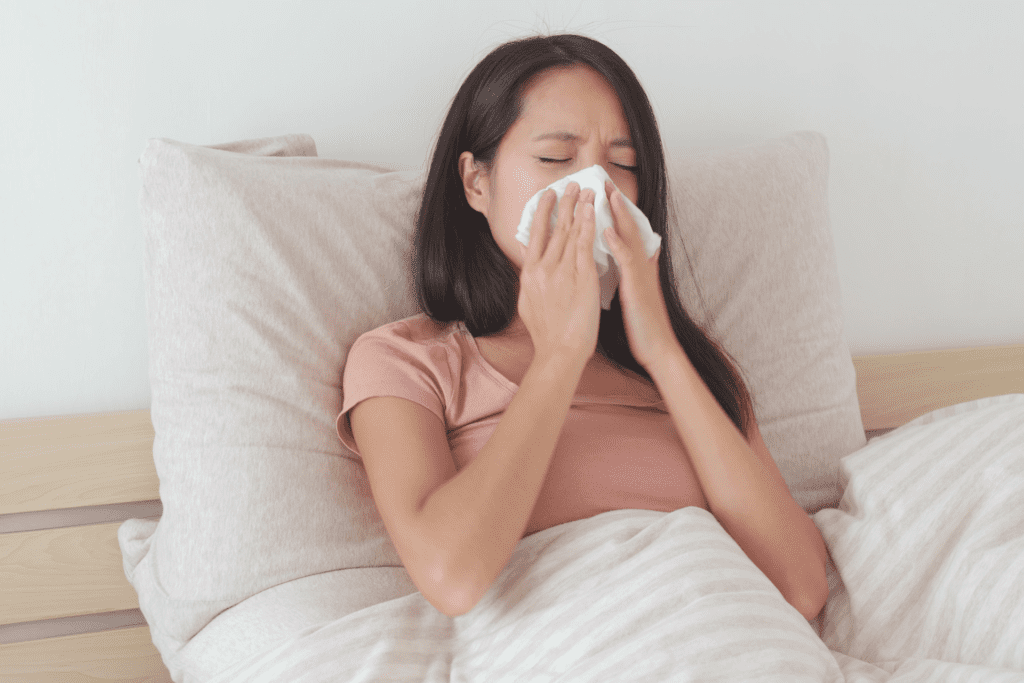Discover why allergies worsen at night and how to create a toxin-free bedroom for restful sleep. Say goodbye to sneezing and hello to health!

Like clockwork, your seasonal allergies are back, bringing with them the all-too-familiar runny nose, sneezing, and itchy, watery eyes. You’ve endured these symptoms time and again, but this season feels different.
The misery doesn’t stop there, as your allergies seem to have an uncanny ability to disrupt your precious sleep. It’s almost as if they conspire to keep you awake through the night.
But what if there’s more to the story?
What if these nighttime allergy struggles aren’t solely due to the rising pollen count outside your window?

Maybe, just maybe, there are toxins lurking around your bedroom in unexpected places, aggravating your allergies and interfering with your sleep.
In this article, we’re getting to the bottom of one question once and for all: why are allergies worse at night?
Why Are Allergies Worse at Night: Possible Culprits
Seasonal allergies are undoubtedly a major contributor to your discomfort.
When the pollen count is high, your body’s immune system goes into overdrive, treating the pollen particles as dangerous invaders, resulting in familiar allergy symptoms.
Another common allergen making things worse in your bedroom? Pet dander that accumulates on your carpet or comforter.
Don’t get me wrong—my pups are my world! But while furry friends make for cozy snuggle buddies, if you’re allergic to your pet, sleeping beside each other isn’t doing you any favors.

The Hidden Culprits: Indoor Triggers
However, it’s not just the pollen wreaking havoc on your sleep sanctuary.
Your bedroom could be harboring indoor triggers that compound your allergy symptoms.
Dust mites and mold are two common allergens found in most bedrooms. They can make their home in your pillows, mattress, or box spring and grow in the walls of older houses or after water damage.
When you lay your head on your pillow at night, you could be unknowingly snuggling up with millions of dust mites.
And those mold spores growing in the corners of your walls might contribute to your nighttime nasal congestion, too.
Unseen Toxins: The Silent Trouble-Makers
Beyond seasonal allergies and common indoor triggers, there might be another, less obvious, cause for your nighttime allergy woes—hidden toxins.
Many of the products we use daily, from the paint on our walls to the bedding we sleep on, can release volatile organic compounds (VOCs) into the air.
Volatile Organic Compounds (VOCs) silently released from non-organic mattresses pose a significant risk to your respiratory health, especially for children who spend long hours in bed.
But it doesn’t stop there.
Hidden within your favorite memory foam pillows are toxic chemicals off-gassing into the air, exacerbating your allergy symptoms and making peaceful sleep an elusive dream.
These VOCs can irritate your respiratory system, causing allergy-like symptoms, such as nasal congestion and eye irritation, even in people without known allergies.
Mattresses, pillows, and other bedroom items made from non-organic materials might be emitting these chemicals, robbing you of a good night’s sleep and affecting your overall well-being.
The Wake-Up Call: 5 Ways To Get A Toxin-Free Bedroom
It’s high time to recognize hidden allergen culprits and take action to create a toxin-free, healthy bedroom where you can finally breathe easy and enjoy a restful night’s sleep, free from allergy woes.

Creating a toxin-free bedroom can go a long way in alleviating nighttime allergies and ensuring you have a peaceful, restorative slumber.
Your mattress plays a significant role in your sleep quality, but did you know that it could also be a source of harmful toxins?
Firstly, many conventional mattresses incorporate chemical flame retardant chemicals to comply with safety standards.
While effective in preventing fires, these toxic chemicals can emit fumes over time, potentially causing respiratory issues and other adverse health effects.
Secondly, some mattresses contain Polyvinyl Chloride (PVC), a synthetic material known for its durability.
However, PVC can release harmful chemicals into the air, raising concerns about cancer risks and hormone disruption.
The combination of flame retardant chemicals and PVC in non-organic mattresses underscores the importance of choosing organic alternatives made from natural materials, which eliminate exposure to these toxic substances, promoting a healthier sleep environment for all.
Make a conscious choice to invest in an organic mattress made from natural materials such as organic cotton, natural latex, or wool.
These mattresses are free from toxic flame-retardants and PVC, providing a healthier and safer sleep surface for you and your loved ones.
Recommended Product: EOS ORGANIC LATEX MATTRESSES
Your pillow is another vital component of a restful night’s sleep.
However, traditional pillows, particularly those made from memory foam, can off-gas toxic chemicals and accumulate dust mites over time.
Opt for non-toxic pillow options, such as natural latex pillows or organic materials like wool.
These pillows are resistant to dust mites and provide the support you need without introducing hazardous chemicals into your bedroom.

Recommended Product: Solid Organic Latex Pillow
- Keep Dust Mites at Bay with Hypoallergenic Bedding
Dust mites can wreak havoc on allergy sufferers, causing sneezing, congestion, and skin irritations.
Combat these tiny intruders and improve air quality by choosing hypoallergenic bedding, including mattress covers, pillowcases, and sheets.
These specially designed products create a barrier against dust mites, preventing them from settling in your sleeping space and sabotaging your healthy bedroom.
- Banish Indoor Pollutants with Proper Ventilation
Proper ventilation is crucial for reducing indoor air pollutants. Open your windows regularly to allow fresh air to circulate and sweep away VOCs emitted by household furnishings and activities.
Additionally, consider investing in an air purifier to filter out allergens and toxins, ensuring you breathe cleaner air while you sleep.
- Dust and Vacuum Regularly for a Clean Sleep Haven
Don’t underestimate the power of regular dusting and vacuuming in maintaining a clean and allergen-free bedroom.
Dust and vacuum your bedroom at least once a week, focusing on areas like your mattress, curtains, and bedroom corners where allergens tend to accumulate.
Use a vacuum cleaner equipped with a HEPA filter to trap even the tiniest allergens and particles, ensuring a cleaner sleeping environment.

Rest Easy and Toxin-Free With More Of BYN’s Clean Picks
At Beautiful You Naturally, we believe in living a toxin-free lifestyle, starting with the products we use every day. Shop more clean, non-toxic lifestyle products here.